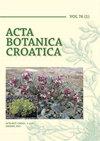低、高辐照水平对柠檬草生长和PSII效率的影响。
IF 0.7
4区 生物学
Q3 PLANT SCIENCES
引用次数: 4
摘要
植物的生长和繁殖依赖于驱动光合作用的光能。在本研究中,我们比较了在两种不同照射条件下生长的小柠檬的生长特性、光合色素含量和光系统II(PSII)性能:低光照(LL)-50μmolPHOTONS m-2 s-1和高光照(HL)-500μmolPHOTONS m-2 s-1。主要目标是研究确保适应不同光照条件的光合调节机制,并将这些观察结果与植物繁殖和生物量生产的数据相结合。为此,我们测量了叶绿素(Chls)和类胡萝卜素(Cars)的含量,并通过饱和脉冲法以及Chl-a瞬态诱导和JIP试验分析了PSII的能量通量。通过比较LL和HL对植物增殖和新鲜生物量的影响,发现对生长的影响主要归因于LL中生物量的减少,而对植物数量的影响要小得多。总叶绿素和Cars含量在暴露于HL的植物中降低,这表明对增加的辐照度的长期适应反应。此外,HL植物在光合作用中表现出更好的利用吸收光的能力,同时对一定数量的PSII反应中心进行光保护调节,使其从活性功能模式转变为耗散功能模式。总之,我们的研究表明,浮萍植物对不同的照射条件具有很大的调节潜力,这不仅在光照有效性可变的情况下,而且在同时受到其他一些环境干扰(如不同污染物)的挑战时,都可能具有重要意义。本文章由计算机程序翻译,如有差异,请以英文原文为准。
Effects of low and high irradiation levels on growth and PSII efficiency in Lemna minor L.
Plant growth and reproduction depend on light energy that drives photosynthesis. In the present study we compared growth characteristics, photosynthetic pigments content and photosystem II (PSII) performance in Lemna minor L. grown in two different irradiation regimes: low light (LL) – 50 μmolPHOTONS m-2 s-1 and high light (HL) – 500 μmolPHOTONS m-2 s-1. The main goal was to investigate the photosynthetic regulatory mechanisms that ensure adjustment to different light conditions and integrate these observations with the data on plant multiplication and biomass production. For this purpose, we measured chlorophyll (Chls) and carotenoid (Cars) contents and analyzed the energy fluxes through the PSII by saturation pulse method as well as by Chl a transient induction and JIP test. In a comparison of the effect of LL and HL on plant multiplication and fresh biomass, it was shown that the effect on growth was primarily attributed to the biomass reduction in LL while the effect on number of plants was much smaller. Total Chl and Cars contents were decreased in plants exposed to HL which indicated long-term acclimation response to the increased irradiance. Furthermore, the HL plants revealed better capability for the utilization of absorbed light in photosynthesis accompanied by photoprotective adjustment of certain number of PSII reaction centers from active to dissipative mode of functioning. In conclusion, our study showed that duckweed plants had great adjustment potential to different irradiation conditions, which might be of great importance not only under variable light availability but also when simultaneously challenged by some other environmental disturbance (e.g. different pollutants).
求助全文
通过发布文献求助,成功后即可免费获取论文全文。
去求助
来源期刊

Acta Botanica Croatica
PLANT SCIENCES-
CiteScore
2.50
自引率
0.00%
发文量
34
审稿时长
>12 weeks
期刊介绍:
The interest of the journal is field (terrestrial and aquatic) and experimental botany (including microorganisms, plant viruses, bacteria, unicellular algae), from subcellular level to ecosystems. The attention of the Journal is aimed to the research of karstic areas of the southern Europe, karstic waters and the Adriatic Sea (Mediterranean).
 求助内容:
求助内容: 应助结果提醒方式:
应助结果提醒方式:


